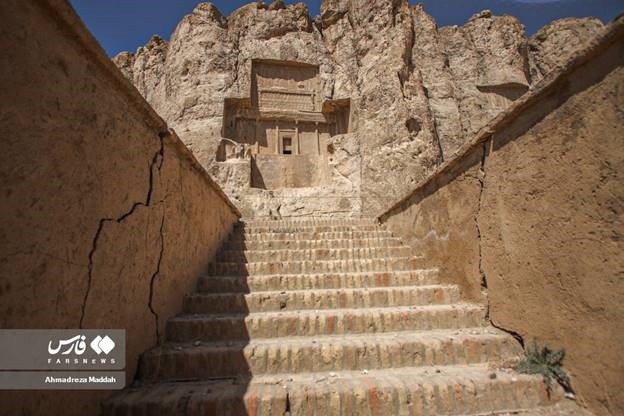TEHRAN – The hot summer, unauthorized deep-water drilling, and other challenges associated with the changing climate are threatening to destroy invaluable cultural landmarks including Naqsh-e Rostam, which is a majestic rock-hewn necropolis in southern Iran.
On Monday, Fars news agency released a collection of images that highlighted arrays of long serious cracks appearing inside the Achaemenid era (c. 550 – 330 BC) site.
“We are witnessing the emergence of numerous cracks and natural subsidence of the ground in this historical site, which will cause damage to this site in the long run,” Fars wrote.
Some experts believe the presence of numerous pump houses and the arbitrary extraction of underground water for agricultural purposes around this historical site among the causes of the damage, the news agency wrote.
One of the wonders of the ancient world, Naqsh-e Rostam, which bears arrays of scenic Sassanid bas-relief carvings, is situated near the UNESCO-designated Persepolis
The necropolis embraces four tombs where Persian Achaemenid kings are laid to rest, believed to be those of Darius II, Artaxerxes I, Darius I, and Xerxes I (from left to right facing the cliff), although some historians are still debating this.
There are stunning bas-relief carvings above the tomb chambers that are similar to those at Persepolis, with the kings standing on thrones supported by figures representing the subject nations below. There are also two similar graves situated on the premises of Persepolis, probably belonging to Artaxerxes II and Artaxerxes III.
Beneath the funerary chambers are dotted with seven Sassanian era (224–651) bas-reliefs cut into the cliff depict vivid scenes of imperial conquests and royal ceremonies; signboards below each relief give a detailed description in English.
At the foot of Naqsh-e Rostam, in the direction of the cliff face, stands a square building known as Ka’beh-ye Zardusht, meaning Kaaba of Zoroaster. The building, which is roughly 12 meters high and 7 meters square, probably was constructed in the first half of the 6th century BC, although it bears a variety of inscriptions from later periods.
Though the Ka’beh-ye Zardusht is of great linguistic interest, its original purpose is not clear. It may have been a tomb for Achaemenian royalty or some sort of altar, perhaps to the goddess Anahiti, also called Anahita believed to be associated with royalty, war, and fertility.
Naqsh-e Rostam, which literary means “Picture of Rostam” is named after a mythical Iranian hero which is most celebrated in Shahnameh and Persian mythology. Back in time, natives of the region had erroneously supposed that the carvings below the tombs represent depictions of the mythical hero.
AFM

